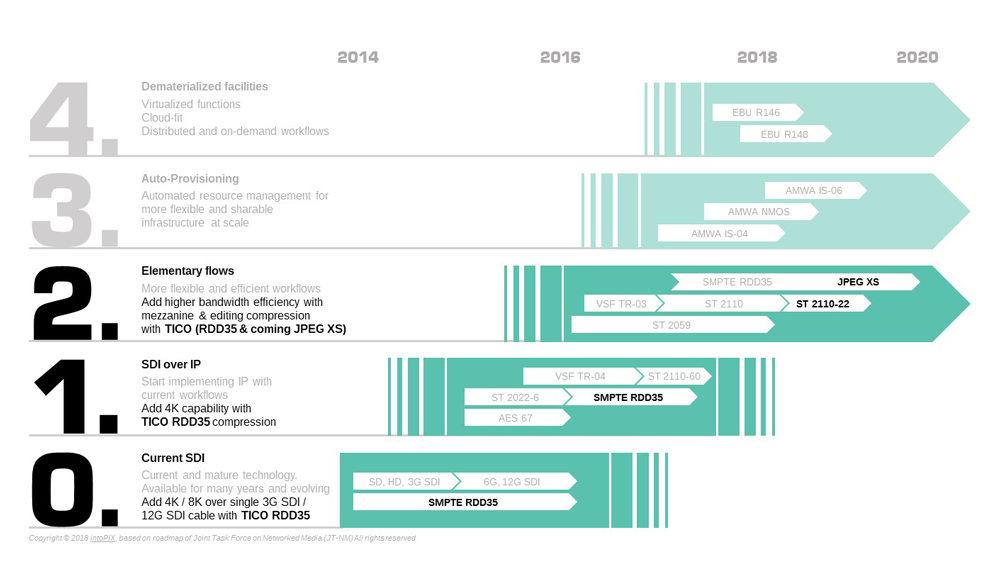TICO has become a broadly adopted technology for lightweight, ultra-low latency video compression. But now suddenly, we start hearing about a new “TICO-XS” and several questions come up:
- Why do we even need another codec?
- How is it related to the original TICO?
- It sounds an awful lot like this JPEG XS that everyone is talking about … is that the same?
Let’s answer those questions one by one.
Why another codec?
TICO was originally developed to replace uncompressed video in the audiovisual industry. An industry in great change due to 2 factors:
- Everyone is moving from SDI to IP
- Video data is reaching unprecedented amounts thanks to 4K, HDR, and higher frame rates
The JT-NM (Joint Task Force on Networked Media) set up a roadmap in 2014 which visualizes this transition from pure SDI to IP and eventually virtualization in a time-frame of roughly 6 years.

It started out with pure SDI being the widespread way of doing and moved to step number one, the mapping of SDI over IP. This is defined by the ST 2022-6 where the SDI signal, consisting of video, audio and ancillary data in one package, is simply mapped onto IP. Here the original TICO-RDD35 (standardized by the SMPTE) comes into play. By compressing at 4:1 it allows the transport of 4K - instead of just HD over a single 3G-SDI or even mapping multiple 4K streams onto 10Gb Ethernet. This allowed the industry to keep their existing infrastructures, while still upgrading to UHD resolutions.
From 2017 we started looking at step 2: Elementary flows. Thanks to SMPTE’s ST2110 there is no more packaged SDI stream. Video, audio, and ancillary data are sent separately over IP, leading to much greater flexibility. Hence, we have a separate video stream to be compressed. Even more now, we are also facing an addition to ST 2110. Namely part 22 – specifically defining IP transport for compressed essence. This created a new use case for which we were looking to deploy a more suitable codec. And that is why we came up with a new TICO product family member: “TICO XS”
How is TICO-XS related to TICO-RDD35?
As mentioned above, TICO-XS is a new family member. However, with increased compression efficiency. Depending on your content, we can compress down to 1 bit per pixel and you won’t witness any quality loss. In bitrate this means compressing a 4K60 stream down to somewhere between 1,6 Gbps or even 500 Mbps. On top, it still keeps the properties that we all love about TICO RDD35 - virtually no latency, a very low complexity, and an extremely low power consumption.
It sounds like JPEG XS that everyone is talking about … is it the same?
It does, and you are right, they are very much related. About the same time SMPTE ST2110 was coming up, the JPEG committee announced a call for proposals for a new lightweight compression standard, called JPEG XS. TICO was submitted and actually selected as the baseline for further development. After that, intoPIX’s engineers (working together with other JPEG committee members) used the original TICO-RDD35 as a basis to develop JPEG XS
So TICO-XS is in fact compliant with the upcoming ISO standard JPEG XS - a very important step for simple, industry-wide adoption
Summed up, you’re working with SDI or hybrid SDI/IP networks and want to upgrade to UHD?
TICO RDD35 is your solution! If you’re looking for higher compression efficiency, especially relevant for ST2110 systems? TICO-XS is your go-to option.
Therefore TICO XS is not replacing TICO, it’s merely an evolution that goes along with the technological development in the media industry. And best of all, it’s ISO standardized as JPEG XS!
